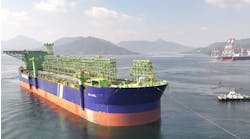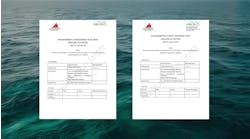Lars Mogensen
Densit A/S
The Baltic Beta jackup, fabricated in 1977, was used for 17 years as a drilling and production platform by various comp-anies in the North Sea under the names Dyvi Beta and West Beta. Since 1994, the rig has been operated by Poland's Petrobaltic as a production platform in the Baltic Sea under its present name.
Originally, the Beta jackup was designed for a 25-year service life. Petrobaltic now intends to operate the platform in its present location until 2011, extending its original design life by 10 years. Because the rig has passed its original design life, the owner has decided to enhance the fatigue strength of the platform prior to the expected deterioration of the integrity of the jackup structural members. This approach has significant economical benefits compared to the potential repair bill if the rig were left in its "as-built" condition.
The project consisted of two stages: a numerical analysis of the entire structure of the jackup and structural strengthening of selected members or parts.
Numerical analysis
The main purpose of the numerical analysis was to estimate cumulative fatigue damage to the lower part of the legs and to the spud cans over the period from the start of rig operation in 1977 to the planned withdrawal of the platform from service in 2011.
Three scenarios in the rig history have been identified for selection of the essential design parameters and for the subsequent fatigue analysis:
- 17 years of operation in the North Sea
- Eight years of operation in the Baltic Sea in "as-built" condition
- 10 years of future operation in the Baltic Sea in reinforced condition.
Emphasis was laid on fatigue checks of tubular joints, butt welds between cast nodes and truss members, vertical welds in cast pieces of chord K-joints, diagonal brace to spud can connections, and leg chord to spud can connections. From experience, these structural details are known to suffer the greatest fatigue damage and have limited or no access to site inspections.
The fatigue life of structural members and joints was calculated based on the S-N curve fatigue approach and under assumption of the linear cumulative fatigue damage. Based on the numerical analysis and fatigue assessments, it was concluded that filling the jackup legs and all the horizontal and inclined members with high performance grout, from spud can level to Bay 10, would significantly improve the fatigue strength of the leg members and joints.
Structural strengthening
Strengthening the lower parts of the legs involved application of the Ducorit S5 grout, produced by Densit, of Aalborg, Denmark. Ducorit products have been used in the offshore industry for the last seven years in various strengthening projects worldwide, provi- ding high compressive strength (approximately 19,000 psi) and stiffness (8,000 ksi) as well as early strength development. The high strength and durability of these products result in fatigue strength greater than that of normal concrete – up to 50 times greater or more, depending on the static strength of the concrete. Ducorit products also exhibit low shrinkage, allowing the grout and surrounding steel to remain in physical contact after curing. Further, owing to the material composition and low water/cement ratio, the products exhibit limited heat of hydration, eliminating the risk of thermal cracking and deterioration, even when casting in large volumes.
For this project, the material was delivered in 800-kg pre-mixed bags to the jackup, where it was mixed with water and pumped into the structure via a piston pump. Flow rate of this system is approximately. 3 to 4 cu m per hour.
As a "grout filling" exercise, the project was complex because the vertical legs were interconnected with all the horizontal and inclined members via small, 30-40-mm holes. The entire filling for one leg (approximately 100 cu m) had to be mixed and pumped into the leg in one operation so that gravity could disperse the grout into the structure. At the same time, the grout level was monitored via remotely controlled TV cameras to ensure 100% grout filling.
Due to the design of the jackup rig, the grout had to be pumped 60 m vertically into a 2.5-in. rubber hose to the top of the leg structure and then 135 m vertically down inside the leg in a 2-in. steel pipe.
It took roughly 35 hours to fill each of the three legs, and the job was carried out without disturbing the daily work on the platform. This strengthening program should ensure the Baltic Beta remains in service for at least another 10 years.




